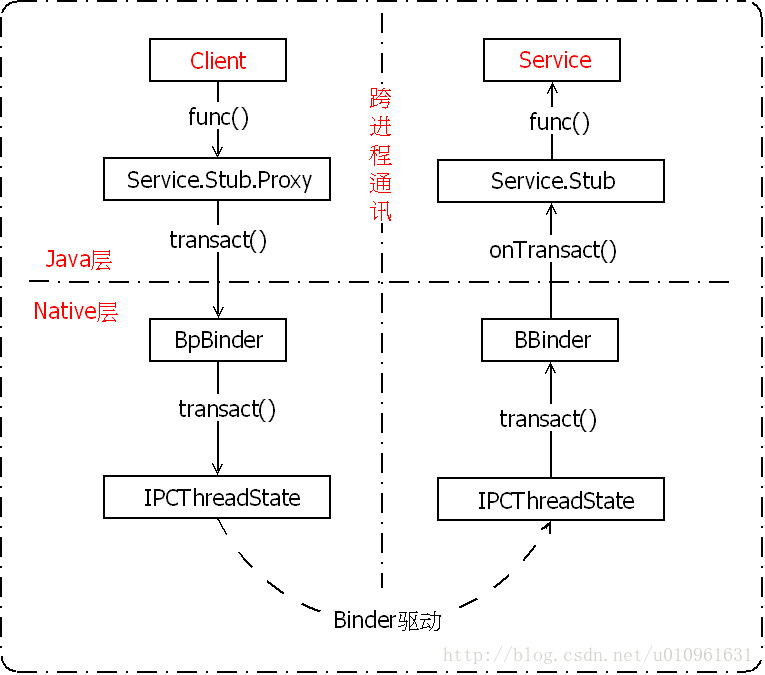Android Binder机制(1501210451 张志康)
学号:1501210451 姓名:张志康 专业:集成电路工程
本文主要分析native层和Java层的Android binder通信机制。
binder是Android最为常见的进程通信机制之一,其驱动和通信库是binder的核心,分别由C和C++编写,应用程序通过JNI同底层库进行关联,也就是native层驱动和通信库通过Java层包装后被Java层调用。
源代码网址:http://androidxref.com/4.2_r1/
参考博客:http://blog.csdn.net/coding_glacier/article/details/7520199
一、native层整体通信流程
通信流程概要
在探究binder通信流程之前,首先我们需要了解Binder机制的四个组件:Client、Server、Service Manager和Binder驱动程序。关系如图:
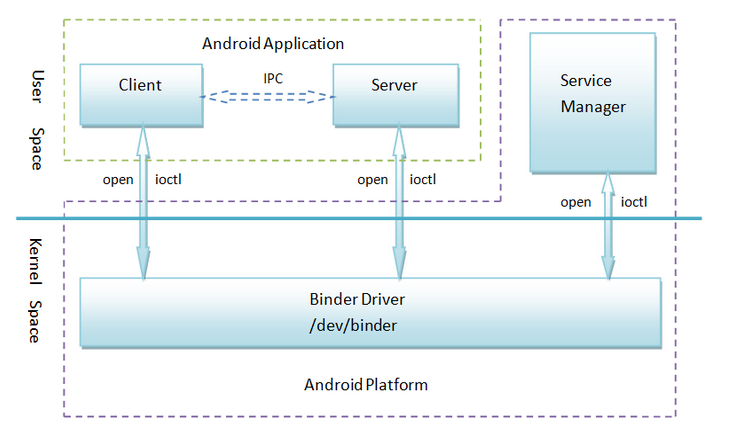
应用程序最终目的是完成Client组件和Server组件之间的通信。ServiceManger对于大家而言是一个公共接入点,0便是ServiceManger的句柄值。
从表面看通信建立的流程便是注册和获取的过程: 1、client通过参数(Parcel包)传递进行通信请求;
2、在收到通信请求时,Server组件需要通过0这个句柄值访问ServiceManger,在ServiceManger中注册一个binder实体。并关联一个字符串;
3、Client组件通过0这个标识去访问ServiceManger,通过一个字符去查询Server组件的引用,此ServiceManger将Server注册的binder实体的一个引用传递给Client端,此时client便可根据这个引用同server进行通信了。
由以上可知,在收到请求时server将一个binder实体传递给C进程,而client得到的只是binder的一个引用,进而调用binder实体的函数。BpBinder和BBinder分别代表binder 的引用和实体,它们均继承自IBinder类。
在描述具体流程之前我们先来了解binder通信中需要用到的三个主要基类:
1.基类IInterface: 为server端提供接口,它的子类声明了service能够实现的所有的方法;
2.基类IBinder BBinder与BpBinder均为IBinder的子类,因此可以看出IBinder定义了binder IPC的通信协议,BBinder与BpBinder在这个协议框架内进行的收和发操作,构建了基本的binder IPC机制。
3.基类BpRefBase client端在查询SM获得所需的的BpBinder后,BpRefBase负责管理当前获得的BpBinder实例。
ServiceManger
首先我们来了解一下在通信流程中ServiceManger所做的工作。
ServiceManger是一个linux级进程,是一个service管理器(service向SM注册是,service就是一个client,而ServiceManger便是server),即我们前边提到的:每一个service被使用之前,均要向ServiceManger注册,客户端通过查询ServiceManger是否存在此服务来获取service的handle(标识符)。
ServiceManger入口函数为:service_manager.c 位于:/frameworks/base/cmds/servicemanager/ int main(int argc, char **argv) { struct binder_state *bs; void *svcmgr = BINDER_SERVICE_MANAGER; bs = binder_open(128*1024); if (binder_become_context_manager(bs)) { ALOGE("cannot become context manager (%s)\n", strerror(errno)); return -1; } svcmgr_handle = svcmgr; binder_loop(bs, svcmgr_handler); return 0; } 主要工作: 1. 初始化binder,打开/dev/binder设备,在内存中为binder映射128Kb空间。 bs = binder_open(128*1024); 其中binder_open位于binder.c中,源代码为: struct binder_state *binder_open(unsigned mapsize) { struct binder_state *bs; bs = malloc(sizeof(*bs)); if (!bs) { errno = ENOMEM; return 0; } bs->fd = open("/dev/binder", O_RDWR); …… return 0; } 2. 指定SM对于代理binder的handle为0,即client尝试同SM通信时创建一个handle为0的代理binder。 void *svcmgr = BINDER_SERVICE_MANAGER; svcmgr_handle = svcmgr; 其中BINDER_SERVICE_MANAGER在binder.h中被指定为0: #define BINDER_SERVICE_MANAGER ((void*) 0) 3. 通知binder driver(BD)使SM成为BD的context manager; if (binder_become_context_manager(bs)) { LOGE("cannot become context manager (%s)/n", strerror(errno)); return -1; } binder_become_context_manager(bs)源码位于binder.c中: int binder_become_context_manager(struct binder_state *bs) { return ioctl(bs->fd, BINDER_SET_CONTEXT_MGR, 0); } 4.进入一个死循环,不断读取内核的binder driver,查看是否有对service的操作请求,如果有调用svcmgr_handler来处理请求操作: binder_loop(bs, svcmgr_handler); binder_loop(,)源码位于binder.c中: void binder_loop(struct binder_state *bs, binder_handler func) { int res; struct binder_write_read bwr; unsigned readbuf[32]; …… } } 5.维护一个svclist列表来存储service的信息。 源码位于service_manager.c: int svcmgr_handler(struct binder_state *bs, struct binder_txn *txn, struct binder_io *msg, struct binder_io *reply) { struct svcinfo *si; …… }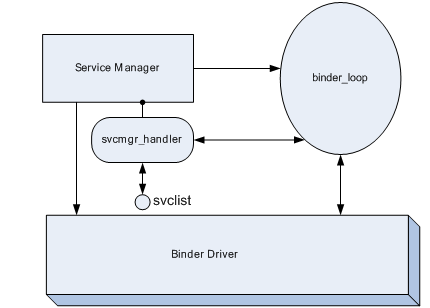
ProcessState
ProcessState是每个进程在使用Binder通信时都需要维护的,用来描述当前进程的binder状态。
ProcessState主要完成两个功能:
1.创建一个thread负责与内核中的binder模块进行通信(Poolthread)。
在Binder IPC中,所有进程均会启动一个thread来负责与binder来直接通信,也就是不断读写binder,这个线程主体是一个IPCThreadState对象(具体介绍见第4节)。
Poolthread启动方式:ProcessState::self()->startThreadPool(); /frameworks/native/libs/binder/ProcessState.cpp 136void ProcessState::startThreadPool() { AutoMutex _l(mLock); ` if (!mThreadPoolStarted) { mThreadPoolStarted = true; spawnPooledThread(true); } }2.为知道的handle创建一个BpBinder对象,并管理进程中所有的BpBinder对象。
BpBinder在第一节已经提到,其主要功能是负责client向BD发送调用请求的数据,是client端binder通信的核心,通过调用transact向BD发送调用请求的数据。
ProcessState通过如下函数获取BpBinder对象:
/frameworks/native/libs/binder/ProcessState.cpp sp<IBinder> ProcessState::getContextObject(const sp<IBinder>& caller) { return getStrongProxyForHandle(0); } sp<IBinder> ProcessState::getStrongProxyForHandle(int32_t handle) { sp<IBinder> result; AutoMutex _l(mLock); handle_entry* e = lookupHandleLocked(handle); …… return result; } ProcessState::handle_entry* ProcessState::lookupHandleLocked(int32_t handle) { const size_t N=mHandleToObject.size(); if (N <= (size_t)handle) { handle_entry e; e.binder = NULL; e.refs = NULL; status_t err = mHandleToObject.insertAt(e, N, handle+1-N); if (err < NO_ERROR) return NULL; } return &mHandleToObject.editItemAt(handle); }在获取BpBinder对象的过程中,ProcessState会维护一个BpBinder的vecto:mHandleToObject(具体调用过程见上述源代码)。
创建一个BpBinder实例时,回去查询mHandleToObject,如果对应的handler以及有binder指针,就不再创建,否则创建并插入到mHandlerToObject中(具体代码见上述的lookupHandleLocked)。
BpBinder构造函数位于/frameworks/native/libs/binder/BpBinder.cpp:
BpBinder::BpBinder(int32_t handle) : mHandle(handle) , mAlive(1) , mObitsSent(0) , mObituaries(NULL) { ALOGV("Creating BpBinder %p handle %d\n", this, mHandle); extendObjectLifetime(OBJECT_LIFETIME_WEAK); IPCThreadState::self()->incWeakHandle(handle); }通过此构造函数我们可以发现:BpBinder会将通信中server的handle记录下来。当有数据发送时,会把数据的发送目标通知BD。
IPCThreadState
IPCThreadState也是一个单例模式,由上边我们已知每个进程维护一个ProcessState实例,且ProcessState只启动一个Pool thread,因此一个进程之后启动一个Pool thread。
IPCThreadState实际内容为:
void IPCThreadState::joinThreadPool(bool isMain) { LOG_THREADPOOL("**** THREAD %p (PID %d) IS JOINING THE THREAD POOL\n", (void*)pthread_self(), getpid()); mOut.writeInt32(isMain ? BC_ENTER_LOOPER : BC_REGISTER_LOOPER); set_sched_policy(mMyThreadId, SP_FOREGROUND); status_t result; do { int32_t cmd; if (mIn.dataPosition() >= mIn.dataSize()) { size_t numPending = mPendingWeakDerefs.size(); if (numPending > 0) { for (size_t i = 0; i < numPending; i++) { RefBase::weakref_type* refs = mPendingWeakDerefs[i]; refs->decWeak(mProcess.get()); } mPendingWeakDerefs.clear(); } numPending = mPendingStrongDerefs.size(); if (numPending > 0) { for (size_t i = 0; i < numPending; i++) { BBinder* obj = mPendingStrongDerefs[i]; obj->decStrong(mProcess.get()); } mPendingStrongDerefs.clear(); } } result = talkWithDriver(); if (result >= NO_ERROR) { size_t IN = mIn.dataAvail(); if (IN < sizeof(int32_t)) continue; cmd = mIn.readInt32(); IF_LOG_COMMANDS() { alog << "Processing top-level Command: " << getReturnString(cmd) << endl; } result = executeCommand(cmd); } if(result == TIMED_OUT && !isMain) { break; } } while (result != -ECONNREFUSED && result != -EBADF); LOG_THREADPOOL("**** THREAD %p (PID %d) IS LEAVING THE THREAD POOL err=%p\n", (void*)pthread_self(), getpid(), (void*)result); mOut.writeInt32(BC_EXIT_LOOPER); talkWithDriver(false); }ProcessState中有2个Parcel成员(mIn和mOut),由以上代码可见,Pool Thread会不断查询BD中是否有数据可读,若有,则保存在mIn;不停检查mOut是否有数据需要向BD发送,若有,则写入BD。
根据第三节提到的:BpBinder通过调用transact向BD发送调用请求的数据,也就是说ProcessState中生成的BpBinder实例通过调用IPCThreadState的transact函数来向mOut中写入数据,这样的话这个binder IPC过程的client端的调用请求的发送过程就讲述完毕。
IPCThreadState有两个重要的函数,talkWithDriver函数负责从BD读写数据,executeCommand函数负责解析并执行mIn中的数据。
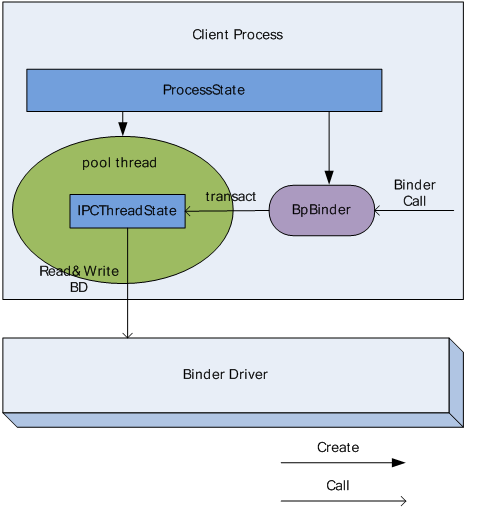
两个接口类
1.BpINTERFACE
client在获得server端service时,server端向client提供一个接口,client在这个接口基础上创建一个BpINTERFACE,使用此对象,client端的应用能够像本地调用一样直接调用server端的方法,而不必关系binder IPC实现。
BpINTERFACE原型如下: /frameworks/native/include/binder/IInterface.h template<typename INTERFACE> class BpInterface : public INTERFACE, public BpRefBase { public: BpInterface(const sp<IBinder>& remote); protected: virtual IBinder* onAsBinder(); };可见,BpINTERFACE继承自INTERFACE、BpRefBase。
BpINTERFACE既实现了service中各方法的本地操作,将每个方法的参数以Parcel的形式发送给BD。同时又将BpBinder作为了自己的成员来管理,将BpBinder存储在mRemote中,BpServiceManager通过调用BpRefBase的remote()来获得BpBinder指针。
2.BnINTERFACE
同样位于/frameworks/native/include/binder/IInterface.h
template<typename INTERFACE>
class BnInterface : public INTERFACE, public BBinder
{
public:
virtual sp<IInterface> queryLocalInterface(const String16& _descriptor);
virtual const String16& getInterfaceDescriptor() const;
protected:
virtual IBinder* onAsBinder();
};
由代码可知,BnInterface继承自INTERFACE、BBinder。
class BBinder : public
IBinder,由此可见,server端的binder操作及状态维护是通过BBinder来实现的。BBinder即为binder的本质。
3.接口类总结
由上节的描述及刚才对于两个接口类源代码分析可知:BpBinder是client端用于创建消息发送的机制,而BBinder是server端用于接口消息的通道。
BpBinder是client创建的用于消息发送的代理,其transact函数用于向IPCThreadState发送消息,通知其有消息要发送给BD,部分源代码如下:
/frameworks/native/libs/binder/BpBinder.cpp
status_t BpBinder::transact(
uint32_t code, const Parcel& data, Parcel* reply, uint32_t flags)
{
if (mAlive) {
status_t status = IPCThreadState::self()->transact(
mHandle, code, data, reply, flags);
if (status == DEAD_OBJECT) mAlive = 0;
return status;
}
return DEAD_OBJECT;
}
default:
return UNKNOWN_TRANSACTION;
}
}
由BBinder的源码可知,其作用是当IPCThreadState收到BD消息时,通过transact方法将其传递给它的子类BnSERVICE的onTransact函数执行server端的操作。部分源码如下:
/frameworks/native/libs/binder/Binder.cpp
status_t BBinder::transact(
uint32_t code, const Parcel& data, Parcel* reply, uint32_t flags)
{
data.setDataPosition(0);
status_t err = NO_ERROR;
switch (code) {
case PING_TRANSACTION:
reply->writeInt32(pingBinder());
break;
default:
err = onTransact(code, data, reply, flags);
break;
}
if (reply != NULL) {
reply->setDataPosition(0);
}
return err;
}
由上述可知,BpINTERFACE,BnINTERFACE均来自同一接口类IINTERFACE,由此保证了service方法在C/S两端的一致性。
- writeStrongBinder和readStrongBinder
writeStrongBinder是client将一个binder传送给server时需要调用的函数。
具体源码如下: status_t Parcel::writeStrongBinder(const sp<IBinder>& val) { return flatten_binder(ProcessState::self(), val, this); } flatten_binder为: status_t flatten_binder(const sp<ProcessState>& proc, const sp<IBinder>& binder, Parcel* out) { flat_binder_object obj; obj.flags = 0x7f | FLAT_BINDER_FLAG_ACCEPTS_FDS; if (binder != NULL) { IBinder *local = binder->localBinder(); if (!local) { BpBinder *proxy = binder->remoteBinder(); if (proxy == NULL) { LOGE("null proxy"); } const int32_t handle = proxy ? proxy->handle() : 0; obj.type = BINDER_TYPE_HANDLE; obj.handle = handle; obj.cookie = NULL; } else { obj.type = BINDER_TYPE_BINDER; obj.binder = local->getWeakRefs(); obj.cookie = local; } } else { obj.type = BINDER_TYPE_BINDER; obj.binder = NULL; obj.cookie = NULL; } return finish_flatten_binder(binder, obj, out); }下边举例说明,addService源码为:
/frameworks/native/libs/binder/IServiceManager.cpp virtual status_t addService(const String16& name, const sp<IBinder>& service, bool allowIsolated) { Parcel data, reply; data.writeInterfaceToken(IServiceManager::getInterfaceDescriptor()); data.writeString16(name); data.writeStrongBinder(service); data.writeInt32(allowIsolated ? 1 : 0); status_t err = remote()->transact(ADD_SERVICE_TRANSACTION, data, &reply); return err == NO_ERROR ? reply.readExceptionCode() : err; }由上述代码块可知,写入到parcel的binder类型为BINDER_TYPE_BINDER,然而SM收到的Service的binder类型必须为BINDER_TYPE_HANDLE才会将其添加到svclist中,因此说,addService开始传递的binder类型为BINDER_TYPE_BINDER然而SM收到的binder类型为BINDER_TYPE_HANDLE,中间经历了一个改变,代码如下:
drivers/staging/android/Binder.c static void binder_transaction(struct binder_proc *proc, struct binder_thread *thread, struct binder_transaction_data *tr, int reply){ …… if (fp->type == BINDER_TYPE_BINDER) fp->type = BINDER_TYPE_HANDLE; else fp->type = BINDER_TYPE_WEAK_HANDLE; fp->handle = ref->desc; …… }由以上函数可知,SM只保存了Service binder的handle和name,当client需要和Service通信时,如何才能获得Service得binder呢?需要由readStrongBinder来完成。
readStrongBinder
Client向server请求时,server向BD发送一个binder返回给SM(保存handle和name),当IPCThreadState收到由返回的parcel时,client通过这一函数将这个server返回给SM的binder读出。
源码为: /frameworks/native/libs/binder/Parcel.cpp sp<IBinder> Parcel::readStrongBinder() const { sp<IBinder> val; unflatten_binder(ProcessState::self(), *this, &val); return val; } unflatten_binder为: status_t unflatten_binder(const sp<ProcessState>& proc, const Parcel& in, sp<IBinder>* out) { const flat_binder_object* flat = in.readObject(false); if (flat) { switch (flat->type) { case BINDER_TYPE_BINDER: *out = static_cast<IBinder*>(flat->cookie); return finish_unflatten_binder(NULL, *flat, in); case BINDER_TYPE_HANDLE: *out = proc->getStrongProxyForHandle(flat->handle); return finish_unflatten_binder( static_cast<BpBinder*>(out->get()), *flat, in); } } return BAD_TYPE; }由如上源码可知:发现如果server返回的binder类型为BINDER_TYPE_BINDER的话,直接获取这个binder;如果server返回的binder类型为BINDER_TYPE_HANDLE时,那么需要重新创建一个BpBinder返回给client。Client通过获得SMhandle来重新构建代理binder与server进行通信。
至此,native通信机制已构建完毕。
二、Java层的binder机制
下边来解析一下java层对于binder的封装过程,分四部分来进行介绍:Java层ServiceManager的结构、如何注册一个Service、如何得到一个Service、Service代理对象方法的过程。
*ServiceManager的结构:
在Java层,ServiceManager的函数源码为:
/frameworks/base/core/java/android/os/ServiceManager.java
public final class ServiceManager {
}
public static IBinder getService(String name) {
}
public static void addService(String name, IBinder service) {
}
public static void addService(String name, IBinder service, boolean allowIsolated) {
}
public static IBinder checkService(String name) {
}
public static String[] listServices() throws RemoteException {
}
public static void initServiceCache(Map<String, IBinder> cache) {
}
由源码可知,ServiceManager没有继承其他类,下边我们来分析ServiceManager管理binder通信的流程。
在Java层注册Service:
通过ServiceManager的addService()可注册自己,其传输了两个参数:String name, IBinder service,分别为name和BBinder的子类对象,跟native层ServiceManager中Service的注册方法相一致。
具体源码如下: public static void addService(String name, IBinder service) { try { getIServiceManager().addService(name, service, false); } catch (RemoteException e) { Log.e(TAG, "error in addService", e); } }getIServiceManager().addService表明将此操作请求转发给了getIServiceManager(),返回一个IServiceManger类型的sServiceManager对象,源码如下:
private static IServiceManager getIServiceManager() { if (sServiceManager != null) { return sServiceManager; } sServiceManager = ServiceManagerNative.asInterface(BinderInternal.getContextObject()); return sServiceManager; }BinderInternal.getContextObject在native层得到BpBinder对象。
ServiceManagerNative.asInterface 将BpBinder封装为Java层可用的ServiceManagerProxy对象。
下面来通过源码具体分析BpBinder封装为ServiceManagerProxy的过程:
static public IServiceManager asInterface(IBinder obj)
{ if (obj == null) { return null; } IServiceManager in = (IServiceManager)obj.queryLocalInterface(descriptor); if (in != null) { return in; } return new ServiceManagerProxy(obj); }由源码可知,通过asInterface的转换,BpBinder对象生成了ServiceManagerProxy对象。也就是说getIServiceManager()得到的是一个ServiceManagerProxy对象,那么ServiceManagerProxy又是什么,下边来具体分析一下。
class ServiceManagerProxy implements IServiceManager { public ServiceManagerProxy(IBinder remote) { mRemote = remote; } public IBinder asBinder() { return mRemote; } public IBinder getService(String name) throws RemoteException { } public IBinder checkService(String name) throws RemoteException { } public void addService(String name, IBinder service, boolean allowIsolated) throws RemoteException { } public String[] listServices() throws RemoteException { } public void setPermissionController(IPermissionController controller) throws RemoteException { } private IBinder mRemote; }由源码可知,ServiceManagerProxy继承自IServiceManager,提供add、get、list、check等方法。由以上分析可知,通过getIServiceManager的便可得到ServiceManagerProxy对象,调用其addService方法便可进行注册,addService源码如下:
public void addService(String name, IBinder service, boolean allowIsolated) throws RemoteException { Parcel data = Parcel.obtain(); Parcel reply = Parcel.obtain(); data.writeInterfaceToken(IServiceManager.descriptor); data.writeString(name); data.writeStrongBinder(service); data.writeInt(allowIsolated ? 1 : 0); mRemote.transact(ADD_SERVICE_TRANSACTION, data, reply, 0); reply.recycle(); data.recycle(); }可知,将name和Service对象封装到Parcel中,调用transact()方法送出,并将当前操作标记为ADD_SERVICE_TRANSACTION,根据上一章提到的内容,transact()便会调用到BpBinder中,此时便进入到native层的使用,这部分内容已经在上一章节分析完毕,具体流程图如下:
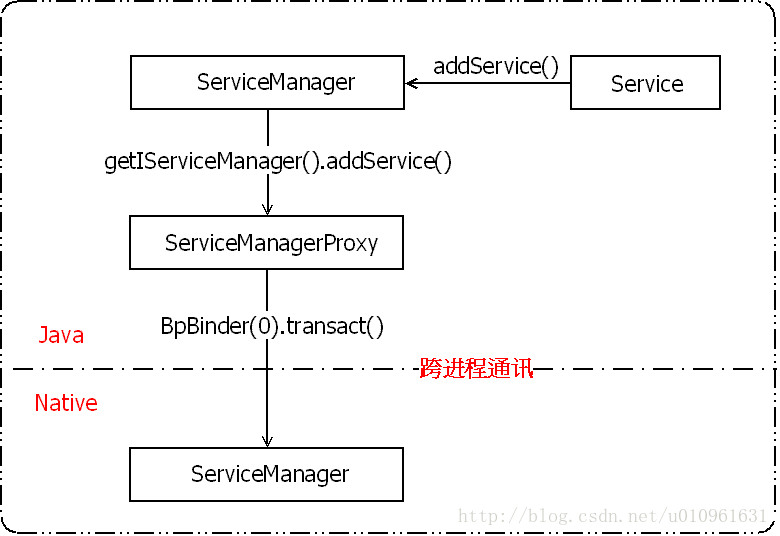
客户端得到一个Service:
主要流程如下:通过Java层的ServerManager得到相应的Service,然后通过asInterface()将得到的对象转为客户端可直接调用的代理对象,然后调用代理对象的updateAdnRecordsEfBySearch()方法。
具体分析如下: 首先,通过ServerManager得到相应的BpBinder对象。 源码位于ServerManager.java中 public static IBinder getService(String name) { try { IBinder service = sCache.get(name); if (service != null) { return service; } else { return getIServiceManager().getService(name); } } catch (RemoteException e) { Log.e(TAG, "error in getService", e); } return null; } 可见,调用getIServiceManager()对象的getService()方法,代码如下。 private static IServiceManager getIServiceManager() { if (sServiceManager != null) { return sServiceManager; } // Find the service manager sServiceManager = ServiceManagerNative.asInterface(BinderInternal.getContextObject()); return sServiceManager; }
可知通过IServiceManager得到的是一个ServiceManager在Java层的代理对象,下边来分析此代理对象的getService( )方法。
/frameworks/base/core/java/android/os/ServiceManagerNative.java
public IBinder getService(String name) throws RemoteException {
Parcel data = Parcel.obtain();
Parcel reply = Parcel.obtain();
data.writeInterfaceToken(IServiceManager.descriptor);
data.writeString(name);
mRemote.transact(GET_SERVICE_TRANSACTION, data, reply, 0);
IBinder binder = reply.readStrongBinder();
reply.recycle();
data.recycle();
return binder;
}
可见,getService请求被转交给native层,由上一章分析可知,native层得到请求后会将目标Service的BpBinder返回给客户端,得到BpBinder对象后,通过asInterface()得到一个Proxy对象,客户端便通过这个代理类调用服务端定义的各种方法。具体客户端得到Service的流程图如下:
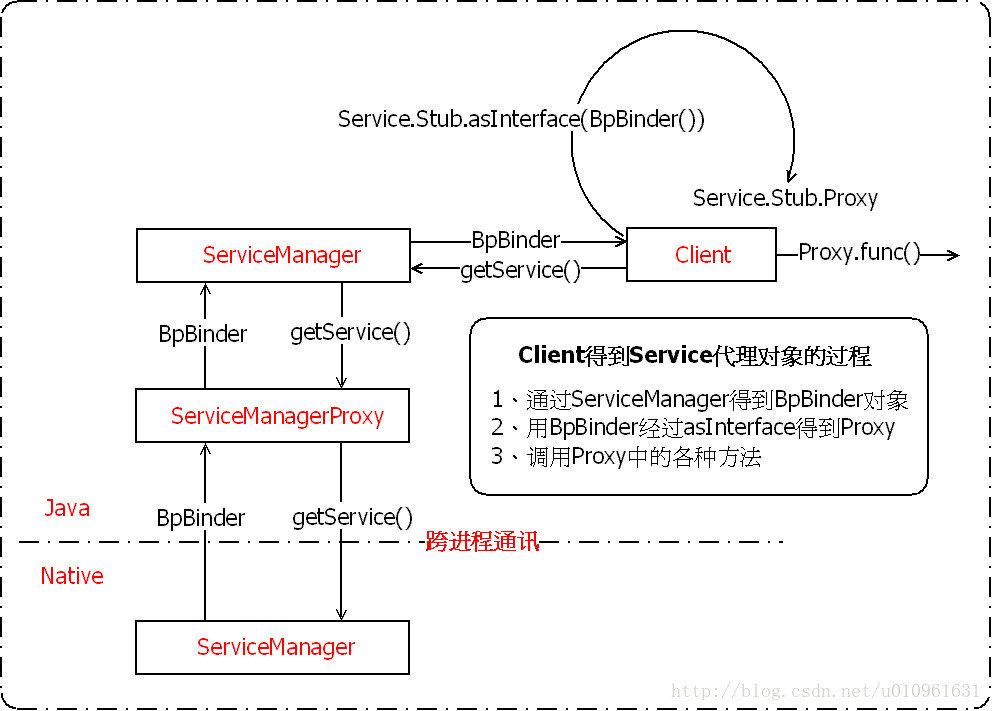
三、总结
Binder通信整体流程图如下:
